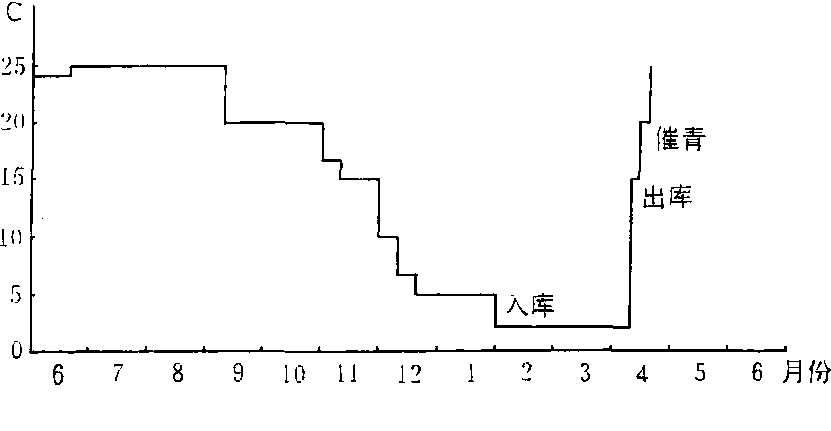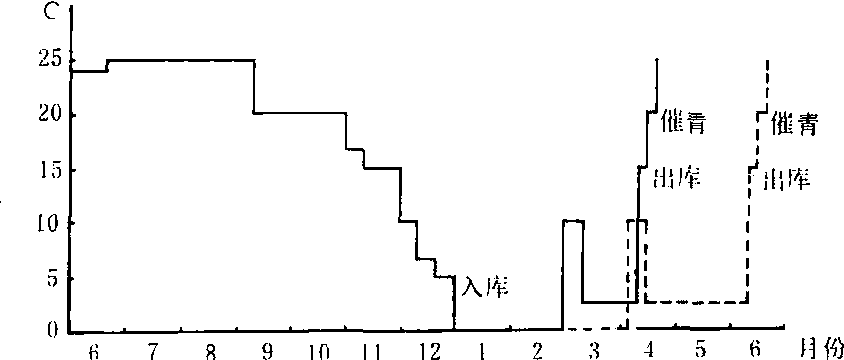蚕种冷藏cold storage of mulberry silkworm eggs
对越年蚕种进行抑制的低温保护,便于催青前调节,促使孵化齐一的技术措施。越年蚕种经过15℃以下低温保护,蚕卵逐渐解除滞育(见蚕的滞育),成为活性卵。活性卵感受10℃以上的温度,胚胎就会缓慢发育,为了防止胚胎发育不齐或过早孵化,有效地控制蚕种的催青孵化时期,达到随时出冷库催青的目的,必须在适当日期,用一定的温度对蚕种进行冷藏保护。
蚕种冷藏的胚胎,从甲胚子(滞育期)到丙2胚子(最长期) 的各胚胎发育阶段,对低温抵抗力比较强,都可以进行冷藏,在此范围内,胚子愈幼小,对低温的抵抗力愈强,愈能耐长期冷藏,冷藏的温度也愈低。胚子发育超过丙2,对低温的抵抗力激剧减弱,不宜进行长期冷藏。所以在冬末春初,必须经常解剖胚子观察,确定冷藏适期,以免误时。生产上采用的冷藏胚子和冷藏温度是: 甲胚子冷藏,用0~2.5℃,丙1~丙2胚子冷藏用2.5℃,初期冷藏有继续解除滞育的作用,到完全解除滞育后,利用这个阶段的胚胎具有耐低温能力,抑制蚕卵胚胎发育,达到齐一地解除滞育,防止活性卵降低生活力的作用。
越年蚕种冷藏的方法有单式冷藏、中途调整冷藏和复式冷藏3种,春用种采用单式冷藏或中途调整冷藏,夏用种采用复式冷藏。
单式冷藏 越年蚕种在冬季浴种消毒整理后,在种室自然低温中保护,待多数胚胎发生到丙1(最长期前),少数至丙2(最长期)时,入库冷藏,冷藏温度为2.5℃,冷藏日数,最长为90天左右(图1)。

图1 单式冷藏温度示意图
由于气候条件不同,各省区入库时间有先后,这是由于各个地区,夏秋接触高温情况不同,滞育程度不一,解除滞育有快慢,入库冷藏便有先后。
中途调整冷藏 从蚕种经浴种消毒到胚子发育至丙1~丙2程度,需要约2~3个月。在温暖地区自然温度中保护,容易接触到5℃以上温度,使早解除滞育的蚕卵开始发育,从而导致胚胎发育不齐和蚕卵耐冷藏力降低,为此宜进行中途调整冷藏,这种方法既可避免蚕卵感受忽高忽低的温度,又能有效地促进胚胎发育齐一。蚕种浴洗消毒后的保护温度为5~7℃,整理后用5℃冷藏保护到第2年1月中旬把冷库温度由5℃降为2.5℃,经40天左右,出库感温,保护温度为10~15℃,待胚胎发育到多数丙1少数至丙2时,再行第2次入库,冷藏温度用2.5℃。第2次冷藏日数,以离出库催青1个月为原则。
在寒冷地区,蚕卵解除滞育早,但因气温过低抑制了胚胎的发育,直到接触低温的时间,超过了耐冷藏的生理限度,影响孵化率,为此应提早入库冷藏,最好采用复式冷藏法。

——春制越年蚕种的保护和复式冷藏的适期标准-----夏用种入库冷藏的适期标准
图 2 复式冷藏温度示意图
复式冷藏 利用胚胎发育各阶段耐冷藏能力,采用分阶段胚子的冷藏适温,进行冷藏。第1次冷藏到该胚胎对低温的感受限度后,中途出库感温,使胚胎发育到另一阶段,恢复其活力,利用这一阶段胚胎耐冷藏的特点,再一次进行冷藏的方法,以延长其冷藏有效时期,因此复式冷藏的有效时间,较单式冷藏长,适于夏用甚至秋用越年种的冷藏。
蚕种在浴洗消毒后,保护在5℃中,胚子达到甲胚子,即进行第1次冷藏,这时约在12月~1月,冷藏温度用0~1℃,冷藏有效期限约100天; 第2次冷藏时间,在蚕种已冷藏近100天时将蚕种出库,进行中途感温,对含有多化性血统,不耐较长冷藏的蚕品种,应尽量缩短后期的冷藏时间,以减少发生白死卵。中途感温,用10~15℃温度,使胚胎发育到丙1、多数见丙2时,用2.5℃进行第2次冷藏,冷藏期限又可达100天左右。这样两次冷藏期限可达200天,在生产上夏用越年种的复式冷藏,不过150天左右,远在安全范围之内图2。
蚕种冷藏
通常指对越冬后的活性化蚕种进行冷藏保护,以控制饲育时期的方法。可避免蚕种因早春气温上升而导致胚子发育不齐或孵化过早,蚁蚕无叶可食。